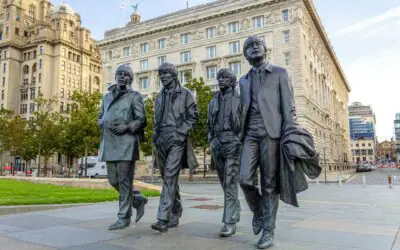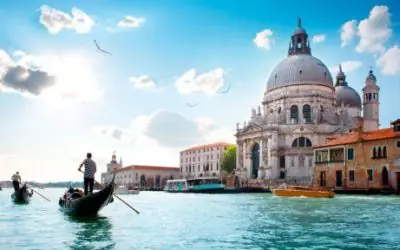When we enter a museum,
what we are normally looking for is a Sense of Surprise.
A museum is said to be “worth the entrance” (in terms of time and money spent to see it) when it can satisfy our hope to learn something new; when it challenges our previous knowledge and our perception of ourselves and the world around us.
The world is full of culture but also of boring museums that sell themselves better than what they actually are. In this article, I list to you 7 not-so-mainstream museums focused on different topics (history, arts, humanity, technology, etc.) that in my experience are “worth the entrance hundred times”.
These are museums I found out (sometimes also by pure chance) while traveling across the world and that, in my humble opinion, can truly provide different and valuable experiences that will stick with you for the rest of your whole life.
So, if you find yourself in one of those places at some point, be sure not to miss them out!
Now, time to start! 😀
1. Museum of tomorrow
(Rio de Janeiro, Brazil)
The Museum of Tomorrow (“Museu do amanha” in Portuguese) is a science museum in Rio de Janeiro that opened its doors just a few years ago (in 2015) and is surely bound to make a great name for itself; hence it stays on top of the list.
The permanent exhibition (and largest part of the museum) focuses on humanity. The good, the bad, and the ugly of humanity, The complexity, the simplicity, the beauty, the intelligence, and the stupidity of human beings and human societies.
The exhibition is structured as a path divided into five areas (Cosmos, Earth, Anthropocene, Tomorrow, and Us) that guides the visitor through time; from the creation of the universe to the history of humans, its impact on the environment and the future scenarios we face.
Although the whole museum is exciting and worth seeing (it takes approx. 2 hours), two are the highlights that I found absolutely stunning and I can totally recommend as a must-see: Cosmos & Earth.
Cosmos
“We are the void.
We are time and space.
We are light.
We are energy.
We are matter.
We are atoms.
We are the Universe”
The first area, Cosmos, is a giant hi-tech “cinema ball” which uses 360° projection technology to steal the visitor from its thoughts. Inside this ball, an 8-minute video about the history of the universe and humanity is played.
Well, what can I say? It is hard to describe: it’s a tear-dropping experience, it is an experience that makes you feel part of everything, positive and beautiful. It is not allowed to make any video or photo inside, so it’s up to you to believe me and try it, but I cannot recommend this experience enough, it is truly astonishing.
The narration of the video is in Portuguese, so if you don’t understand the language I would highly suggest checking first the concept of the video here.
Earth
We are Life.
We are rhythm and movement.
Diversity.
Words and silence.
We are memories.
Knowledge.
And invention.
We are Earth.
In this second part of the museum, we found dark rooms with squared columns. On top of each column is a topic (ex. Religion, Consumption, Family, etc.); on each side, a sub-topic (ex. Religion: death, birth, marriage, initiation), and under it are photos portraying those specific aspects of humanity around the world.
The photos, their superior quality, and the clever disposition make this area of the museum a 360° celebration of humanity. Personally, I felt I could stroll around those dark rooms for hours, cuddling myself in disbelief and astonishment.
Conclusion
The rest of the museum (Anthropocene, Tomorrow & Us) is highly interactive and focuses on the impact of human lives on our environment and the necessity of using resources wisely to draw our possible future.
Overall, for an entrance price of 20Real (~4Euro), the Museum of Tomorrow is definitely an experience that will enhance your trip to Rio de Janeiro and is worth putting on your museum’s bucket-list.
2. War Remnants Museum
(Ho Chi Minh, vietnam)
If every person on Earth would have the chance to see this museum once, wars would cease to exist.
The War Remnants Museum has been established in 1975 as a War Crimes Museum and portrays the history of the Vietnam War and the First Indochina War.
The museum consists of a three-floors building where military tools and photo collections are exposed, but be aware: it is far from being your average war museum and to enter here you’ll need to prepare to hold your tears and stomach.
What makes this hidden gem so special and a memorable monument to humanity’s sick side is the choice of the photos here exposed: nude, crude, brutal, vicious, violent. The museum portrays the truth of war uncensored: disrespect of human life, merciless war crimes, chemical tortures, death.
The point of view of the museum is visibly Vietnam-sided and contra-American which in itself is an interesting perspective on how the war was perceived in this small country and how narrations widely differ between factions.
But this is not the main point of the museum. The cornerstone of the exposition, in my opinion, is throwing in the face of the visitors the stupidity, the ugliness, and the horror of war to force them to think of a better way to solve conflicts and ultimately improve humanity as a whole. The gruesome pictures and the short captions are there to shock and to underline the underrated radiance of peace.
The War Remnants Museum is not an easy museum to stroll around to just pass an afternoon and I would strongly advise against bringing children younger than 12. It took us a bit more than two hours to visit the museum and honestly I can say that it has been a powerful experience that for sure make you reflect on the meaning of war and the value of human life.
The entrance fee is a symbolic 15.000VND (0,60Euro) and is kept so low on purpose, to give everyone the possibility to visit this spectacular, yet demanding museum. Although it will unlikely be your easiest visit, if you’re around Ho Chi Minh the War Remnants Museum is a place not to be missed.
3. Hakone Open Air Museum
(Gora, Japan)
On the way to Owakudani on the Hakone Circle Trip, the little train makes a stop in Gora, an apparently small village neglected by most tourists anxious to complete their tour and arrive at their destination. If you are not in a hurry and can take a couple of hours off your path, you should definitely stop here.
In fact, in Gora is located the Hakone Open Air Museum, a modern-contemporary art museum immersed in the lush nature of the Hakone mountains.
The beauty of this museum lays in the surprises behind the corners, the enigmatic and unconventional art that leaves you wondering, and the surrounding natural environment which both relaxes and sharpens your senses.
The exhibition is structured along a path. On your way through, the first thing you’ll spot is a wide array of modern and surrealistic compositions/statues from many international artists all immersed in the beauty of the Japanese gardens. Picasso, Mirò & Moore are only a few of the artists present there; the list is unending.
Within the whole museum’s park, more than 100 masterpieces are scattered around for you to find. Also, there are pavilions and indoor exhibitions, a creative playground area for children, and a sensory walking path to relax your feet.
I personally see this museum as an underrated black pearl which likely suffers for its position (close to many other hotspots of the region and where tourists are often on a tight schedule).
Extremely peaceful, surprisingly charming, and overall a greatly relaxing experience; for the price of 1600YEN (~13Euro) the Hakone Open Air Museum is a safe bet for your buck and an enriching adventure.
4. Inhotim Institute (Brumadinho, Brazil)
Brasil maybe also a land of paradoxes, but museums are clearly not playing around and that’s why it’s the only country scoring two museums on this list.
Opened in 2006, the Inhotim Institute was created from the beginning with the idea of becoming a world-leading contemporary art museum. As of 2020, it likely became the n.1 open-air museum in Latino America and is scratching the very edge also in worldwide terms.
Let’s start with the dimensions. Inhotim is massive! 7.86 km² huge! In fact, the open-air museum is spread out over a gargantuan park which in 2010 also got recognized as a botanical garden thanks to its over 5000 plant species and 1800 kinds of palm alone (overall more than 28% of the plant families known worldwide).
Within the park, there are over 1500 masterpieces from international artists coming from 30 countries around the world, 23 pavilions (19 permanent and 4 for temporal exhibitions) of around 1000 square meters each, and three restaurants.To help visitors move around there’s even a bus-shuttle service (!) in the case you don’t feel like walking.
The philosophy of the institue is what makes this place so special. The concept of the park is in fact, to bridge communities with contemporaneity by creating new ways of accessing the cultural assets provided. Inhotim is not a go-to-stare museum; is a sensorial experience, a path of research for meaning and surprise. The best way to enjoy the park is, in my opinion, to get lost within it.
Imagine Inhotim as a walk in the park with benefits! 😉 The spatial relationship between nature and art allowed artists to create beyond the borders of urban museums. Here, you can find pools installations where to bath, dark rooms with hammocks and hard rock music, larger-than-life masterpieces that don’t want to be watched but they want you to take photos with them.
I would personally describe Inhotim as: art’s irreverence toward its own traditional standards. All in all, due to its size, this is one of those few museums where you wouldn’t feel guilty to spend a second day.
Its geographical location (60km away from Belo Horizonte in the state of Minas Gerais) I believe is what somehow still prevents it from being visited as it deserves to be; but believe me, if you get are traveling to Brazil and have a full day to fit in, go for Inhotim: it will be one of the most gorgeous and memorable places you’ll ever visit!
The entrance price is 78Real (~14Euro) and it is important to add to it the price to get there (as it is not too close to main cities (excluding Belo Horizonte). If you’re traveling in a small group, our best suggestion is to rent a car as it makes reaching the museum much easier and stress-free.
5. Propaganda Poster Art Center,
(Shanghai, China)
After the largest, we come to the smallest (and most hidden!) museum on this list.
The Propaganda Poster Art Centre is a private collection of graphic arts that immerses the visitor into the life of 20th century China and the art used for indoctrination and power enhancement purposes by the Communist Chinese Party.
The exhibition consists of only two (!!!) rooms and it’s well hidden in the basement of a condo. The best way to find it once in front of the building is to ask the doorman to show you the way (and he’ll be happy to do so). What makes this place so special is that you’ll definitely not expecting such a beautiful cultural site when descending the grey old stairs leading to the entrance.
The atmosphere within the PPAC is very quiet and silent. On the walls are posters from 1920-1980 that tell the story of China before becoming the huge global power it is today.
The site reports Churchill saying “The empire of the future is the empire of the mind” and in a way, this little museum gives an idea of the tricks used by propaganda (today developed on a whole new scale thanks to modern technologies) to transform and influence the collective mind.
Some curious examples that shine bright to the eye, are how Americans and Europeans were portrayed as ugly, grey failures in times of war, but drawn beautiful and charming in time of necessity. Also, it is interesting to notice how in the early century the praise of common workers was the center of attention, and how at mid-century Mao’s image became more and more prominent at the point of becoming the sun.
The collection values quality over quantity. Every poster has a story and I found myself spending easily two hours in those two rooms just observing and processing the posters, lost in my thoughts with countless questions popping up in my head. I was lucky of having a Chinese friend with me that translated me and gave me some historical background information to form my opinions.
My best advice, if you plan to visit this place and don’t want to rely only on your mobile; is to get a Chinese guide for a couple of hours as it will make your visit much more meaningful and educative. Also looking at their website can be a good way to prepare yourself for the exposition feel.
The entrance fee is 25RMB (~4Euro), a tiny price for a display that you won’t expect to find in the heart of Shanghai.
6. Killing Fields (Phnom Penh, Cambodia)
Here we go back to history to a tragic and recent past that’ll make you shiver and cry on the inside.
We are in Cambodia, back in 1975-1979. In those four years, the Khmer Rouge Regime (the Cambodian communist party at that time) enacted one of the worst genocides seen in history killing over 20% of the Cambodian population. Suspected political enemies, but also intellectuals, professors, doctors, lawyers, and most people with a higher degree of education were arrested and killed.
In the small village of Choeung Ek (at the doors of Phnom Penh, capital of Cambodia) stays tall a monument built with 5000 human skulls. All around, it looks just like a normal field, with trees, small wood-houses, lush grass, and a small lake. The Killing Fields, at first, don’t seem anything like a museum; let alone hell on Earth… but then the visit starts.
At the entrance of the place, you get an audio-guide in the language you prefer and, if the day is rainy like in our case, an umbrella to shelter yourself from the rain. Around the park are small cartels with numbers from 1 to 20, located in the middle of nature where apparently nothing is around. What you need to do, is only press the corresponding button in your audio guide.
The voices you hear are the voices of people that lived and survived the Cambodian genocide. They narrate the history of the massacre they saw in front of their very own eyes with all their emotion. Now is where the museum takes place.
A small wood house becomes a pre-death prison, the leaves of palm trees become the tools used by the regime to cut the necks of prisoners, the grass holes in the ground around become the graves of countless civilians and a tree with colorful wristbands (the one in the photo above) becomes the place where thousands of infants were killed by smashing their head against it.
The experience you live through the audioguide is unconventional and strong; it’s a blade straight to the heart that brings tears to your eyes (we were traveling with friends and I remember crossing with them, both we were staring at a tree and just crying in silence under our umbrella and the rain).
You may be asking yourself why in hell am I recommending this museum. The answer is: this is not just a museum (I am not even sure if we can call it that) but a jump in the past; it’s a soul-crushing experience that will haunt you for hours after you leave but will also open up questions in you, about humanity and about how you want to behave in the future.
At the end of the visit, you will feel grown, more human; you’ll appreciate more our times and the relationships we have today. Cambodians are amongst the most friendly people we met on our travel and we believe that this experience also changed them thoroughly.
The entrance to the Killing Fields Museum is 8USD (around 7 Euro) and the visit takes approx. 90 minutes. Not your average museum, surely not a walk in the park, but definitely a must-see while crossing Cambodia.
7. Fo Guang Shan Buddha Museum (Kaohsiung, Taiwan)
Located in the south of Taiwan, not too far out from Kaohsiung, Fo Guang Shan is both a museum and by far the largest Buddhist monastery in Taiwan. The gigantic Buddhist site is divided into two areas: the Fo Guang Shan shrine & the Fo Guang Shan monumental Buddha Memorial Centre which was built to protect a teeth relic of the Buddha dating many centuries back.
This huge FGS complex is a journey into buddhism’s beliefs; a museum and a journey of self-discovery. Overall, the structure boasts two giant buddha statues (50m & 36m), 8 pagodas, a museum (opened in 2011), a monastery, a Disney-like Buddhist cave, stunning gardens, and something like over 200.000 Buddha’s statues and reproductions (of all sizes!).
In the pyramid, the museum exposes Buddhist art. What makes this place a very fresh experience in our opinion, in addition to the astonishing beauty of the whole place, is the kindness of the monks working in this place, always smiling and willing to tell you more about their culture and religion. Passed the museum, it is possible to enter a huge celebration room where a huge sleeping buddha statue and the Buddha’s teeth are present.
Beware that every visit lasts around half an hour and to see the teeth you’ll likely have to endure a Buddhist mess held only in Chinese (at first we didn’t know and we got stuck in the room, meditating seated cross-legs 😉 ).
In the Shrine, it is possible to breathe the peace and harmony of a true Buddhist temple. At the feet of the shrine, stays a bit hidden a huge hole in the wall, called the “Pure Land Cave”, and this was a huge surprise when we visited. Here is represented the journey of a Buddhist through the different stages of enlightenment with plenty of information about every step.
What’s truly special about this cave though, is not what is represented but HOW it is represented: the artists behind this place decided to employ a Disneyland style scenography: moving statues & lights, strobes, engaging decoration & unexpected storytelling techniques. The cave becomes more mystical and confusing the more you adventure yourself in it but not only. It becomes also funny, kitch, and weird at the same time. It is easy and natural to develop those feelings that surely are not expected when entering a place supposedly religious.
All in all, the Fo Guang Shan Buddha Museum is an extremely visual site that proposes a variety of cultural experiences for all people and of which you visitor are called to make sense of. If you wish to understand more about Buddhism, this is the place to put on your list!
The entrance to the whole FGS site (museum, monastery & cave) is free (although small donations are accepted and are a normal custom to support the site).
Conclusion
Those were 7 World-Class museums that in my opinion are underrated gems that make for a different museum experience and definitely deserve more attention.
Did you know any of them already? Do you know other museums that could fit in this list?
Drop me a comment below to get in touch, I’d love to exchange experiences and get to know new places! 🙂
Travel Glocal: How to Find Truly Local Experiences while Traveling!
On a beach in Brazil, after a football match (2017)As global tourism rises yearly more than before, touristic destinations are increasingly adapting to higher tourism inflows. While this surely made traveling easier and cheaper in the last two decades, in some way it...
15 Curious Fun Facts about Liverpool that will Surprise you!
Liverpool is a lively city and metropolitan borough located on the north-west coast of English and the capital of the English county of Merseyside, which is visited yearly by more than 1 million international tourists and 1,5 domestic visitors annually. A stunning...
10 Reasons why Traveling Europe by TRAIN is Awesome!
Europe is probably the most inter-connected continent in the world: low-cost airlines, long-haul buses, generally well-maintained roads, and of course...trains! The European rail network is extremely vast, as trains have played a major role in developing the whole...
10 Awesome Benefits of Exploring the World with a Travel Buddy
It has been almost 15 years since I discovered how much I LOVE traveling around our gorgeous planet Earth: I love it so much that I also decided to make my mission to work while traveling full-time! During the years, I've been traveling in all kinds of ways (by plane,...





















0 Comments